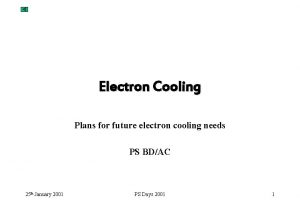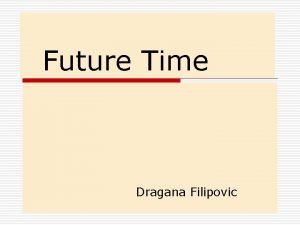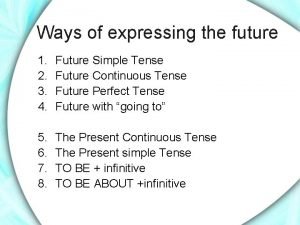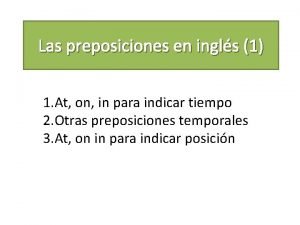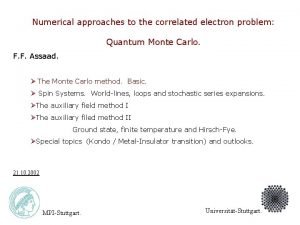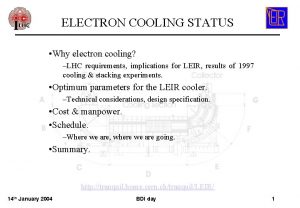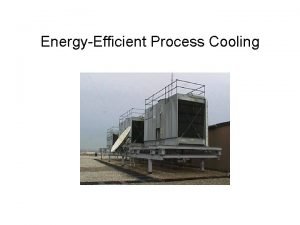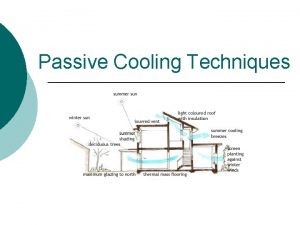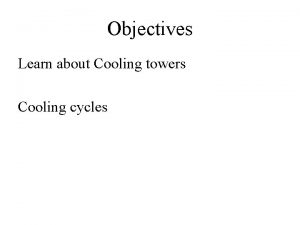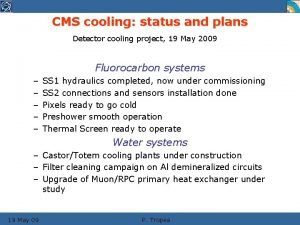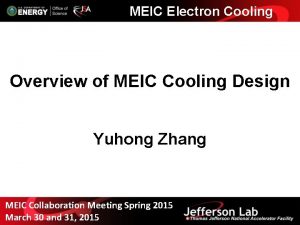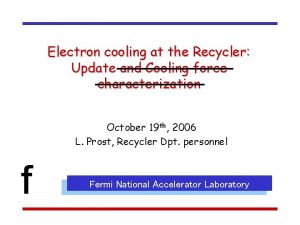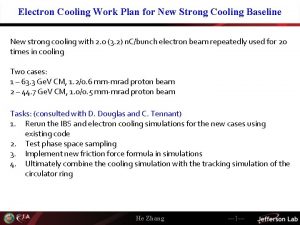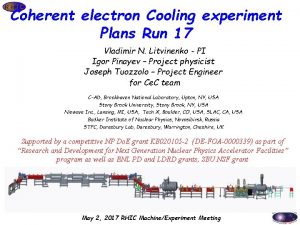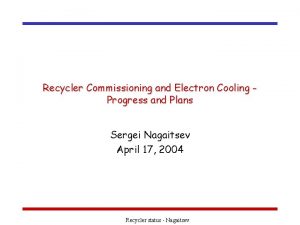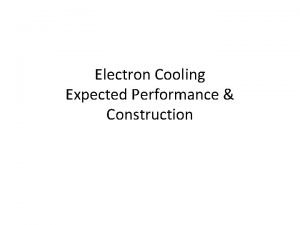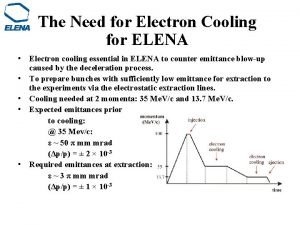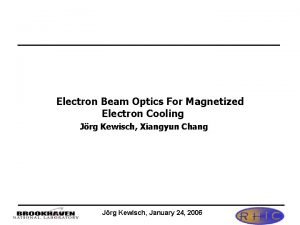Electron Cooling Plans for future electron cooling needs




















- Slides: 20

Electron Cooling Plans for future electron cooling needs PS BD/AC 25 th January 2001 PS Days 2001 1

What is electron cooling? • Means to increase the phase space density of a stored ion beam. • Mono-energetic cold electron beam is merged with ion beam which is cooled through Coulomb interaction. • Electron beam is renewed and the velocity spread of the ion beam is reduced in all three planes. 25 th January 2001 PS Days 2001 2

Analogy with the mixing of gases Two gases of different temperatures T 1 an T 2 tend to an equilibrium temperature T 3 25 th January 2001 As the electron beam is continuously renewed, the ion beam temperature tends to the electron beam temperatu The velocity spread is reduced by a factor (m/M)1/2 PS Days 2001 3

Electron cooling setup • Electron gun: thermocathode, Pierce shield, accelerating anodes – final current given by Child’s Law: I = r. V 3/2 – the parameter r is the perveance and is given by 7. 3 m. P (r/d)2 • Interaction section • Collector • The whole system is immersed in a longitudinal field 25 th January 2001 PS Days 2001 4

Cooling time • Electron cooling theory gives : – where q is the relative difference in angle between the ions and electrons (qi - qe), [qi= ( / )] – the parameter h = Lcooler/Lmachine – and Ie is the electron current. 25 th January 2001 PS Days 2001 5

Electron cooling at CERN • Improve the quality of low energy ion beams – many experiments on LEAR and AD not possible without electron cooling – used to cool (anti)protons, H-, oxygen, and lead ions – first electron cooling device to be used routinely on a storage ring • Increase of the duty cycle of the machine – cooling time much less than what can be obtained with stochastic cooling at low energies (< 310 Me. V/c) • In the future LHC requests a variety of ions – the proposed injection scheme requires fast cooling times and stacking 25 th January 2001 PS Days 2001 6

Results of Pb 54+ cooling and stacking in 1997 • Stacking at the 2. 5 Hz Linac repetition rate • Saturation effect on the accumulated intensity due to vacuum degradation and beam loss • Cooling times of 200 ms obtained with an electron current of 120 m. A • missing a factor of 2 in cooling time and in accumulated intensity 25 th January 2001 PS Days 2001 7

How to decrease the cooling time? • • Make the cooler longer Change the lattice parameters at the cooler Ensure a perfect alignment of electron and ion beams Increase the electron current 25 th January 2001 PS Days 2001 8

Cooling Time Vs. L and Ie Compare measurements made with the standard machine lattice in 1996 (Lecool = 1. 5 m) and in 1997 (Lecool = 3 m ). Inverse transverse cooling time of 88. 86 Me. V/c/u Pb 54+ ions as a function of electron beam intensity for 1. 5 m and 3 m setup. 25 th January 2001 PS Days 2001 9

Cooling Time Vs. Lattice Parameters Cooling times for 300 Me. V/c protons Vs. different values at the cooler Cooling times for 300 Me. V/c protons Vs. different values of D at the cooler Comparison of inverse cooling times for 88. 86 Me. V/c/u Pb 54+ ions Vs. Ie for all tested machine optical settings 25 th January 2001 PS Days 2001 10

Obtaining higher electron beam currents EC EC r. C d 2 a EA EA Anode f =DU Cathode f =0 2 a d Anode f =DU = 45 0 d = 1. 5 cm 2 a = 1 cm r C = 0. 707 cm Cathode f =0 I P I = 0. 82 microperv II P II = 7. 5 PI P II = 6. 1 microperv To have P I = 6. 1 microperv d = 0. 54 cm would be necessary • Analytical studies of diodes in space charge regime have shown that a convex spherical diode has a higher perveance than a planar diode • However the beam emitted from a convex cathode is divergent and hence has large transverse velocities. • STRONG SOLENOIDAL AXIAL FIELD is needed (>1000 G) 25 th January 2001 PS Days 2001 11

Example Gun with convex spherical cathode of half-angle = 450. Simulation with the program SSAM/CERN. Gun geometry provided by A. Shemyakin/FNAL. Ua = 3 k. V , I = 0. 92 A , P = 5. 6 microperv B = 2000 Gauss Beam diameter = 1 cm a= 0. 5 cm 450 25 th January 2001 PS Days 2001 12

25 th January 2001 PS Days 2001 13

Electron beam expansion • Convex cathodes are generally small in size and need a strong axial magnetic field – electron beam is smaller than the injected ion beam – not compatible with insertion in the storage ring • Cure: decrease the axial field adiabatically such that the electron beam size is larger than the ion beam and also the field in the toroids and cooling section does not perturb the machine. 25 th January 2001 PS Days 2001 14

Requested ions for LHC 25 th January 2001 PS Days 2001 15

Required performance of a new ecooler • Electron energy range: 2 ke. V to 55 ke. V • Electron currents between 100 m. A and 3 A (maximum perveance of 4 m. P) • Electron beam diameter of 3. 5 cm in the interaction region (variable? ) • Transverse energies less than 100 me. V • Good beam alignment • Minimum perturbation to the machine (closed orbit, coupling, vacuum) 25 th January 2001 PS Days 2001 16

Parameters for a “state of the art” cooler • Electron beam: – convex cathode, diameter approx. 20 mm – high perveance (4 m. P), variable intensity (multiple anodes) and variable energy • Magnetic field: – Bgun = 0. 6 T, Bdrift = 0. 075 T [Bgun/Bdrift=8] – variable B field will give an expansion factor of 2. 83 • ebeam diameter = 56 mm, transverse energy = 12. 5 me. V 25 th January 2001 PS Days 2001 17

Parameters for a “state of the art” cooler (contd. ) • • Efficient collection (DI/I<10 -4) of the electron beam Cooling length of 3 m Closed orbit and coupling compensation Associated diagnostics 25 th January 2001 PS Days 2001 18

Where are we now? • Theoretical work for the design of a new gun and collector • Linear testbench is being commissioned – spare gun and collector for AD – test of the high perveance electron gun • Tests at other laboratories (MSL, MPI Heidelberg, GSI) – beam expansion, optimum lattice parameters • New ideas – hollow gun – open collector 25 th January 2001 PS Days 2001 19

That’s All For Now 25 th January 2001 PS Days 2001 20
 Future plans and finished future actions
Future plans and finished future actions Future perfect vs future continuous exercises
Future perfect vs future continuous exercises Future perfect continuous and simple
Future perfect continuous and simple Simple claustral complex
Simple claustral complex Strategic gender needs and practical gender needs
Strategic gender needs and practical gender needs Primary needs and secondary needs
Primary needs and secondary needs Target needs and learning needs in esp
Target needs and learning needs in esp Satisfaction
Satisfaction Future of outdoor cooling
Future of outdoor cooling Definite arrangement
Definite arrangement Expressing future plans and arrangements
Expressing future plans and arrangements Future plans present continuous
Future plans present continuous My future plans after school
My future plans after school 7 preposiciones
7 preposiciones The future of the correlated electron problem
The future of the correlated electron problem Past continuous diagram
Past continuous diagram Future continuous.
Future continuous. Perfect future continuous tense
Perfect future continuous tense Future nurse programme
Future nurse programme Nulti kondicional
Nulti kondicional The perfect future tense
The perfect future tense








